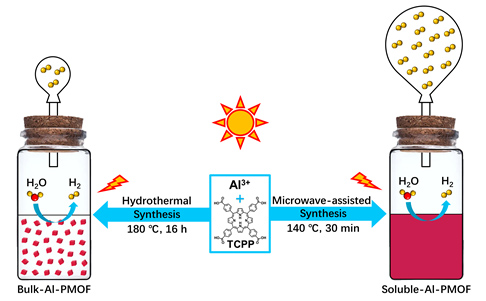[1] Cui, X.; Li, W.; Ryabchuk, P.; Junge, K.; Beller, M. Nat. Catal. 2018, 1, 385.
[2] Copéret, C.; Chabanas, M.; Saint-Arroman, R. P.; Basset, J. M. Angew. Chem., Int. Ed. 2003, 42, 156.
[3] Li, Z.; Ji, S.; Liu, Y.; Cao, X.; Tian, S.; Chen, Y.; Niu, Z.; Li, Y. Chem. Rev. 2020, 120, 623.
[4] Ye, R.; Zhukhovitskiy, A. V.; Deraedt, C. V.; Toste, F. D.; Somorjai, G. A. Acc. Chem. Res. 2017, 50, 1894.
[5] Astruc, D.; Lu, F.; Aranzaes, J. R. Angew. Chem., Int. Ed. 2005, 44, 7852.
[6] Li, H.; Chen, G.; Duchesne, P. N.; Zhang, P.; Dai, Y.; Yang, H.; Wu, B.; Liu, S.; Xu, C.; Zheng, N. Chin. J. Catal. 2015, 36, 1560. (李欢, 陈光需, Duchesne, Paul N.; 张鹏, 代燕, 杨华艳, 吴炳辉, 刘圣洁, 许潮发, 郑南峰, 催化学报, 2015, 36, 1560.)
[7] Jiao, L.; Seow, J. Y. R.; Skinner, W. S.; Wang, Z. U.; Jiang, H.-L. Mater. Today 2019, 27, 43.
[8] Zhang, J.-P.; Zhang, Y.-B.; Lin, J.-B.; Chen, X.-M. Chem. Rev. 2012, 112, 1001.
[9] Zhou, H.-C.; Kitagawa, S. Chem. Soc. Rev. 2014, 43, 5415.
[10] Qian, B.; Li, N.; Chang, Z.; Bu, X.-H. Sci. Sin. Chim. 2019, 49, 1361. (钱彬彬, 李娜, 常泽, 卜显和, 中国科学:化学, 2019, 49, 1361.)
[11] Li, B.; Wen, H.-M.; Cui, Y.; Zhou, W.; Qian, G.; Chen, B. Adv. Mater. 2016, 28, 8819.
[12] Zhou, Z.; Xue, C.; Yang, Q.; Zhong, C. Acta Chim. Sinica 2009, 67, 477. (周子娥, 薛春瑜, 阳庆元, 仲崇立, 化学学报, 2009, 67, 477.)
[13] Yao, M.-S.; Tang, W.-X.; Wang, G.-E.; Nath, B.; Xu, G. Adv. Mater. 2016, 28, 5229.
[14] He, Y.; Tan, Y.; Zhang, J. Acta Chim. Sinica 2014, 72, 1228. (何燕萍, 谭衍曦, 张健, 化学学报, 2014, 72, 1228.)
[15] Huang, R.-W.; Wei, Y.-S.; Dong, X.-Y.; Wu, X.-H.; Du, C.-X.; Zang, S.-Q.; Mak, T. C. W. Nat. Chem. 2017, 9, 689.
[16] Zeng, L.; Guo, X.; He, C.; Duan, C. ACS Catal. 2016, 6, 7935.
[17] Wang, Y.-R.; Huang, Q.; He, C.-T.; Chen, Y.; Liu, J.; Shen, F.-C.; Lan, Y.-Q. Nat. Commun. 2018, 9, 4466.
[18] Chen, X.; Peng, Y.; Han, X.; Liu, Y.; Lin, X.; Cui, Y. Nat. Commun. 2017, 8, 2171.
[19] Xiao, J.-D.; Li, D.; Jiang, H.-L. Sci. Sin. Chim. 2018, 48, 1058. (肖娟定, 李丹丹, 江海龙, 中国科学:化学, 2018, 48, 1058.)
[20] Zeng, J.; Wang, X.; Zhang, X.; Zhuo, R. Acta Chim. Sinica 2019, 77, 1156. (曾锦跃, 王小双, 张先正, 卓仁禧, 化学学报, 2019, 77, 1156.)
[21] Yang, W.; Liang, H.; Qiao, Z. Acta Chim. Sinica 2018, 76, 785. (杨文远, 梁红, 乔智威, 化学学报, 2018, 76, 785.)
[22] Li, D.; Xu, H.; Jiao, L.; Jiang, H.-L. EnergyChem 2019, 1, 100005.
[23] Huang, G.; Chen, Y.; Jiang, H.-L. Acta Chim. Sinica 2016, 74, 113(黄刚, 陈玉贞, 江海龙, 化学学报, 2016, 74, 113.)
[24] Cai, G.; Ding, M.; Wu, Q.; Jiang, H.-L. Natl. Sci. Rev. 2020, 7, 37.
[25] Qiao, W.; Song, T.; Zhao, B. Chin. J. Chem. 2019, 37, 474.
[26] Gao, B.; Zhou, J.; Wang, H.; Zhang, G.; He, J.; Xu, Q.; Li, N.; Chen, D.; Li, H.; Lu, J. Chin. J. Chem. 2019, 37, 148.
[27] Zhang, P.; Li, H.; Veith, G. M.; Dai, S. Adv. Mater. 2015, 27, 234.
[28] Huang, Y.; Wang, Q.; Liang, J.; Wang, X.; Cao, R. J. Am. Chem. Soc. 2016, 138, 10104.
[29] Klinowski, J.; Almeida Paz, F. A.; Silva, P.; Rocha, J. Dalton Trans. 2011, 40, 321.
[30] Fateeva, A.; Chater, P. A.; Ireland, C. P.; Tahir, A. A.; Khimyak, Y. Z.; Wiper, P. V.; Darwent, J. R.; Rosseinsky, M. J. Angew. Chem., Int. Ed. 2012, 51, 7440.
[31] Sun, J.-K.; Zhan, W.-W.; Akita, T.; Xu, Q. J. Am. Chem. Soc. 2015, 137, 7063.
[32] Zhang, S.; Liu, Y.; Li, D.; Wang, Q.; Ran, F. Appl. Surf. Sci. 2020, 505, 144553.
[33] Gao, Z.-Z.; Wang, Z.-K.; Wei, L.; Yin, G.; Tian, J.; Liu, C.-Z.; Wang, H.; Zhang, D.-W.; Zhang, Y.-B.; Li, X.; Liu, Y.; Li, Z.-T. ACS Appl. Mater. Interfaces 2020, 12, 1404.
[34] Luo, Y.; Peng, Y.; Liu, W.; Chen, F.; Wang, B. Chem. Eur. J. 2017, 23, 8879.
[35] Xiao, J.-D.; Shang, Q.; Xiong, Y.; Zhang, Q.; Luo, Y.; Yu, S.-H.; Jiang, H.-L. Angew. Chem., Int. Ed. 2016, 55, 9389.
[36] Fu, Y.; Sun, D.; Chen, Y.; Huang, R.; Ding, Z.; Fu, X.; Li, Z. Angew. Chem., Int. Ed. 2012, 51, 3364.
[37] Xu, H.-Q.; Hu, J.; Wang, D.; Li, Z.; Zhang, Q.; Luo, Y.; Yu, S.-H.; Jiang, H.-L. J. Am. Chem. Soc. 2015, 137, 13440.
[38] Liu, H.; Xu, C.; Li, D.; Jiang, H.-L. Angew. Chem., Int. Ed. 2018, 57, 5379.
[39] Feng, D.; Gu, Z.-Y.; Li, J.-R.; Jiang, H.-L.; Wei, Z.; Zhou, H.-C. Angew. Chem., Int. Ed. 2012, 51, 10307. |
